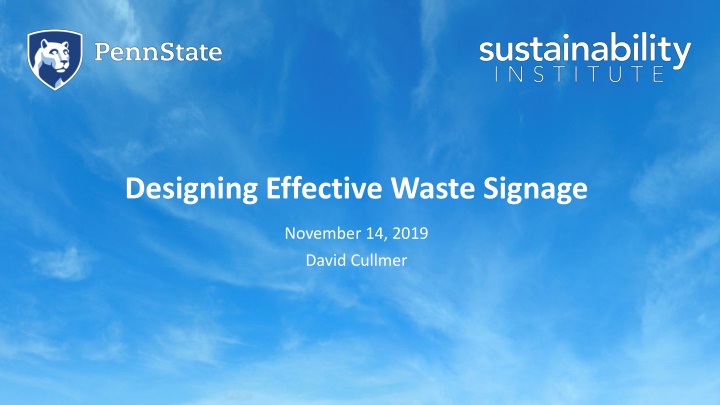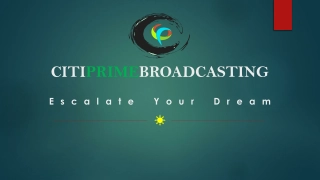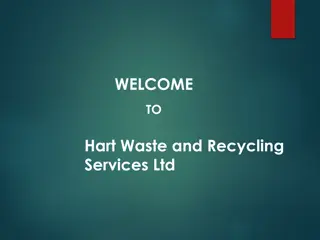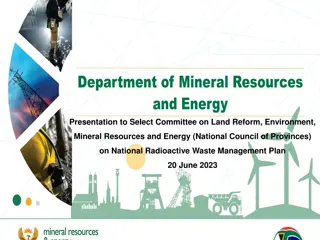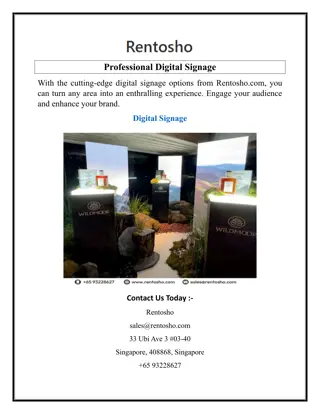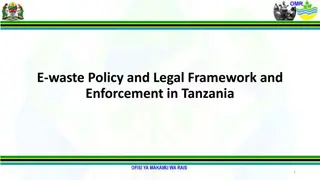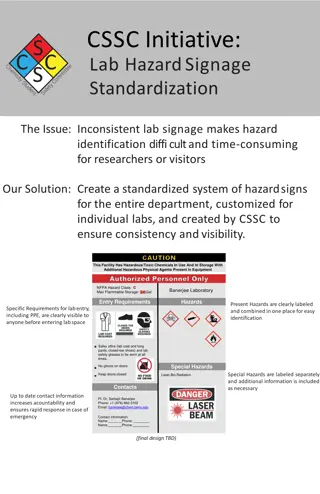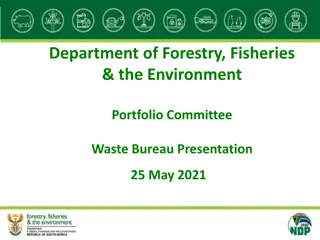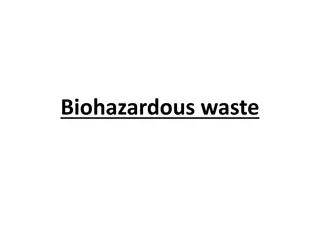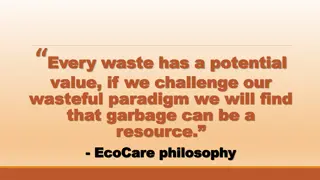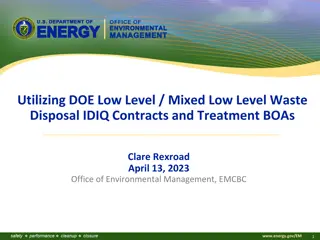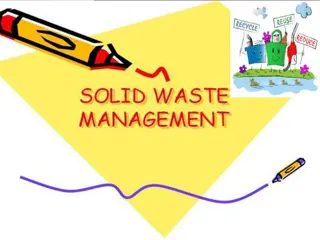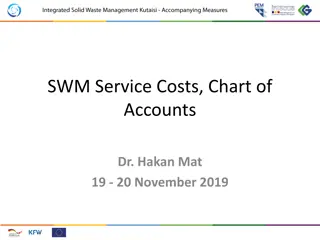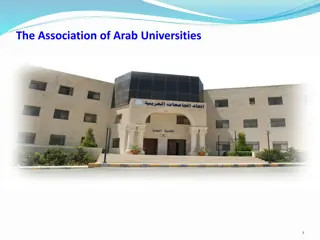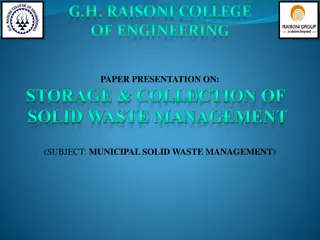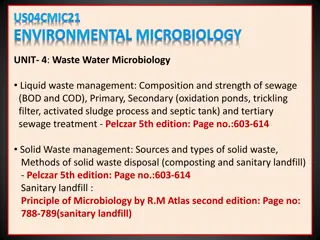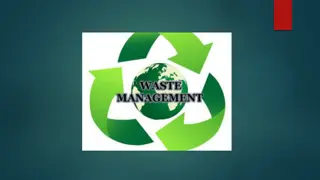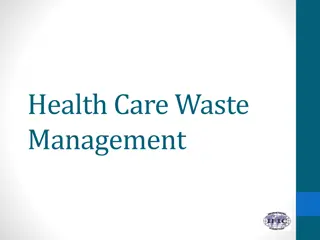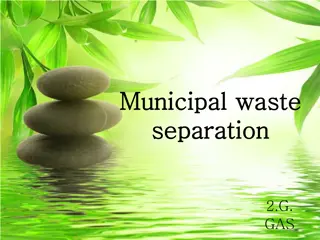Effective Waste Signage Design at Universities
During waste signage design projects, over 15,000 signs were deployed to educate students and faculty on proper waste disposal. Lessons learned emphasized the importance of word choice, color-coding bins, and illustrating bin contents. Research questions were posed to optimize signage for accurate sorting and overcome language barriers. A survey involved 7,500 students and 2,500 faculty/staff, offering insights into sign format preferences. The study aimed to enhance waste diversion rates through improved messaging strategies and signage clarity.
Download Presentation

Please find below an Image/Link to download the presentation.
The content on the website is provided AS IS for your information and personal use only. It may not be sold, licensed, or shared on other websites without obtaining consent from the author.If you encounter any issues during the download, it is possible that the publisher has removed the file from their server.
You are allowed to download the files provided on this website for personal or commercial use, subject to the condition that they are used lawfully. All files are the property of their respective owners.
The content on the website is provided AS IS for your information and personal use only. It may not be sold, licensed, or shared on other websites without obtaining consent from the author.
E N D
Presentation Transcript
Designing Effective Waste Signage November 14, 2019 David Cullmer
~47,000 students ~17,000 faculty and staff 15,229 tons of waste annually Diversion rate of 58% Sorting stations with 7 bins
New Signage Needed Possible bin reductions Programmatic changes Opportunity to apply new messaging strategies
Determining Best Practices Purdue University George Washington University University of British Colombia & Vancouver University of Victoria Keep America Beautiful & Pepsico Recycling Partnership
Lessons Learned Words matter Color code bins Signage should illustrate 80% of bin contents Include frequently confused materials Combine words and illustrations
Research Questions What sign format guides accurate sorting, especially for sometimes and middle of the road recyclers? What sign formats best guides those for whom English is not their native language? Which products are most confusing?
Signage Survey Design and Implementation Survey pool: 7,500 students and 2,500 faculty/staff N=1,294 with 61% students, 33% staff and 6% faculty Launched early April and ran for 2 weeks $100 VISA card incentive 3 sign formats for 4 bins
Sorting Exercise ______ Water Bottle (1) ______ Candy Wrapper (1) ______ Water Bottle (1) ______ Candy Wrapper (2) ______ Used Tissue (2) ______ Coffee Pod (5) ______ Spiral Notebook (2) ______ Solo Cup (3) ______ Gum (3) ______ Styrofoam Container (7) ______ Candy Wrapper (3) ______ Ballpoint Pen (4) ______ Soiled Pizza Box (4) ______ Cheeseburger (10) ______ Soiled Pizza Box (4) ______ Yogurt Container (5) ______ Styrofoam Container (7) ______ Dunkin' Donuts Cup (8) ______ Used Napkin (6) ______ Styrofoam Container (7) ______ Starbucks Cup (8) ______ Soiled Pizza Box (9) ______ Envelope (7) ______ Starbucks Cup (8) ______ Coffee Pod (10) ______ Granola Bar Wrapper (13) ______ Starbucks Cup (8) ______ Starbucks Cup Lid (11) ______ Cheeseburger (11) ______ Condiment Packet (14) ______ Softbound Book (9) ______ Laundry Detergent Bottle (12)
Results Overall correct sorting was highest when photo signage was used (mean = 28.57), followed by icons (mean = 28.13). Accuracy is lowest for text signage (mean= 28.02). Some variation by bin: Compost text and icons slightly more effective Landfill photo and icons slightly more effective than text
Recycling habit classification Recycling Enthusiasm Avid recycler 1% Avid recycler 12% Middle of the road 24% Middle-of-the-road recycler Sometimes recycler Sometimes recycler Not a recycler Not a recycler 63%
Results For non-recyclers and sometimes recyclers: photo signage outperformed text and icons These results were accentuated for non-native English speakers (~8% of the survey pool)
Recycling Beliefs Improve environmental quality Significantly reduce land used for landfills Improve public health Significantly conserve natural resources Build the local economy and create jobs Reduce pollution Eliminates waste from the ocean that is harmful to marine animals
Product Confusion Starbucks hot cups plastic (landfill) Pens plastic (landfill) Gum compost (47%) Soiled napkins and pizza boxes paper (compost)
Thank You The University is committed to equal access to programs, facilities, admission, and employment for all persons. It is the policy of the University to maintain an environment free of harassment and free of discrimination against any person because of age, race, color, ancestry, national origin, religion, creed, service in the uniformed services (as defined in state and federal law), veteran status, sex, sexual orientation, marital or family status, pregnancy, pregnancy-related conditions, physical or mental disability, gender, perceived gender, gender identity, genetic information, or political ideas. Discriminatory conduct and harassment, as well as sexual misconduct and relationship violence, violates the dignity of individuals, impedes the realization of the University s educational mission, and will not be tolerated. Direct all inquiries regarding the nondiscrimination policy to Dr. Kenneth Lehrman III, Vice Provost for Affirmative Action, Affirmative Action Office, The Pennsylvania State University, 328 Boucke Building, University Park, PA 16802-5901; Email: kfl2@psu.edu; Tel 814-863-0471.
